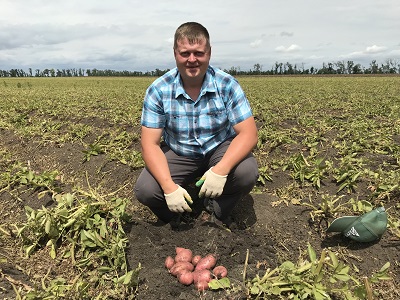100 hectares are allotted for potatoes in the Losev farm. Five varieties are grown: Colombo, Red Scarlet, Red Lady, Evolution and Riviera.
Long trucks with “not our” region codes on the numbers again became frequent in the Medvedovsky settlement. Following the wheat, local farmers began harvesting the second bread – potatoes.
In Medvedovskaya, there are many farms that grow vegetables. This year, 100 hectares of onions and potatoes were planted in the KFH of Petr Alexandrovich and Alexander Losev. Onions, the yield of which has reached 55 tons per hectare, have already been dug up and almost all of them have been sold. The potato harvest is in full swing.
Alexander, the nephew of Losev Sr., who came “to the farm” and began working with his uncle after graduating from the agricultural faculty of KubGAU in 2011, is very pleased with the current potato crop in the peasant farm. Although, he says, not all Medvedev’s vegetable growers produced the second bread in the same way. It seems that everyone has enough equipment, and they fertilized, and no one really hoped for the sky: they watered. It is not for nothing that the Medvedovsky settlement is known as an anomalous zone: when it rained over the region in April and May, the local farmers did not get rain. The conditions seem to be the same, but the difference in harvest is striking: the Losevs have excellent crops, the neighbors have not so much.
Five time-tested varieties are grown on the Losev farm: Colombo, Red Scarlet, Red Lady, Evolution and Riviera. The best result was given by fields with colombo – over 60 tons per hectare. The Reviera lagged behind her a little – 58 tons, “the least” gave red scarlet for the circle – 44 tons. We haven’t counted how many have grown yet: potatoes are still being dripped.
- We do not experience a lack of customers, they come from all over for our potatoes, just have time to fill the trucks. The price that has developed for the crop is almost at the level of profitability, but if it were even a couple of rubles more, I would be just happy, – says the farmer.
It is impossible to keep the tubers to the best price, although the farm has three cold storage warehouses, they are going to build a fourth one with the largest storage capacity – up to 2.5 thousand tons. It makes little sense to “hide” potatoes until better times, according to Alexander, due to the peculiarities of storing the first crop, because the potatoes brought from the field now are “hot”, at least 16-17 degrees. You can’t put this in the refrigerator, which means you can’t save it. So you have to give it to “outbid” directly from the field. Another thing is the second potato. It will be dug in the fall at a temperature of 6-8 degrees Celsius, at which it will be well stored. In the meantime, in the refrigerator only seed potatoes for the second harvest. It has already begun to be planted in fields freed from onions.
KFH does not live by vegetables alone. Winter cereals also give excellent results in the economy. This year, says Alexander, the yield of barley has reached 80 centners per hectare, wheat – 70. All crops in the enterprise’s economy seem to complement each other. If the harvest of one is “not very good”, then on the second, third, and so on, it should definitely work out.
Such stability, according to Alexander Losev, allows the peasant farm to develop and acquire equipment. Moreover, the best and most multifunctional, and to do this even in conditions where the price of units has grown significantly. Last year, for example, a powerful domestic grain harvester RSM-161 and a sorting line for potatoes were purchased. This is a huge buller, which is produced by Rostselmash under license. The tractor and all trailers to it, allow the unit alone to manage all operations on an arable farm area of 800 hectares.
By the way. According to the district agricultural administration, onion and potatoes are planted on 411 and 685 hectares in the Timashevsky district, respectively. The onion was completely harvested with a gross result of 9.7 thousand tons and an average yield of 235 centners per hectare. Potatoes are dug out on half of the planned areas. The gross harvest amounted to 5.8 thousand tons, the yield was 200 centners per hectare.

